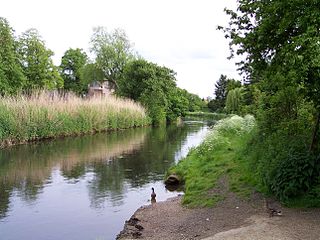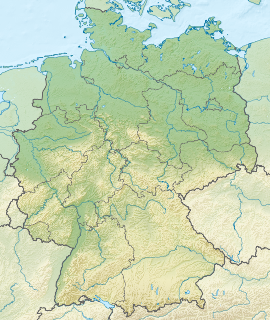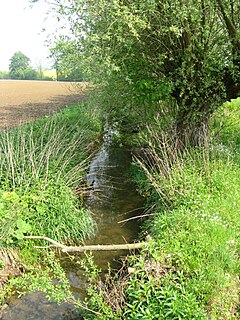
Westphalia is a region in northwestern Germany and one of the three historic parts of the state of North Rhine-Westphalia. It has an area of 20,208 km2 (7,802 sq mi) and 7.9 million inhabitants.

The Sauerland[ˈzaʊɐlant] is a rural, hilly area spreading across most of the south-eastern part of North Rhine-Westphalia, in parts heavily forested and, apart from the major valleys, sparsely inhabited. For these reasons, it has been chosen as the first place in Germany to reintroduce the Wisent.

Detmold is one of the five Regierungsbezirks of North Rhine-Westphalia, Germany, located in the north-east of the state. It is congruent with the administratively not existent area of Ostwestfalen-Lippe (OWL).

The Sieg is a river in North Rhine-Westphalia and Rhineland-Palatinate, Germany. It is a right tributary of the Rhine.

The Vechte or Vecht, often called Overijsselse Vecht in the Netherlands to avoid confusion with its Utrecht counterpart, is a river in Germany and the Netherlands. Its total length is 182 km (113 mi), of which 107 km (66 mi) are on German soil.

Ahr is a river in Germany, a left tributary of the Rhine. Its source is at an elevation of approximately 470 metres (1,540 ft) above sea level in Blankenheim in the Eifel, in the cellar of a timber-frame house near the castle of Blankenheim. After 18 kilometres (11 mi) it crosses from North Rhine-Westphalia into Rhineland-Palatinate.

The Niers is a river in Germany and The Netherlands, a right tributary of the river Maas (Meuse). Its wellspring is near Erkelenz, south of Mönchengladbach, in North Rhine-Westphalia (Germany).

The Heller is a 30 km long river in western Germany. It is a left tributary of the Sieg. The source is located near Haiger in Hesse. It flows through Burbach and Neunkirchen in North Rhine-Westphalia. It flows into the river Sieg in Betzdorf, Rhineland-Palatinate. Its basin area is 204 km².

The Wupper is a right tributary of the Rhine in the state of North Rhine-Westphalia, Germany. Rising near Marienheide in western Sauerland it runs through the mountainous region of the Bergisches Land in Berg County and enters the Rhine at Leverkusen, south of Düsseldorf. Its upper course is called the Wipper.

The Kyll, noted by the Roman poet Ausonius as Celbis, is a 128 km long river in western Germany, left tributary of the Moselle. It rises in the Eifel mountains, near the border with Belgium and flows generally south through the towns Stadtkyll, Gerolstein, Kyllburg and east of Bitburg. It flows into the Moselle in Ehrang, a suburb of Trier.

The Dinkel is a river in Germany and the Netherlands, left tributary of the Vecht. Its total length is 89 km (55 mi), of which 47 km (29 mi) in Germany. The Dinkel originates in North Rhine-Westphalia, Germany, between Ahaus and Coesfeld. It flows north to Gronau, crosses the border with the Netherlands (Overijssel), flows through Losser, Denekamp, and recrosses the border to Germany. The Dinkel joins the Vechte in Neuenhaus.

Rhinau is a commune in the Bas-Rhin department of Grand Est in north-eastern France.

The Else is a left tributary of the river Werre in the northeast of North Rhine-Westphalia and in southern Lower Saxony. The Else is a distributary of the river Hase and begins at a river bifurcation near Melle.

Germany is a country in west-central Europe, that stretches from the Alps, across the North European Plain to the North Sea and the Baltic Sea. Germany has the second largest population in Europe and is seventh largest in area. The territory of Germany covers 357,021 km2 (137,847 sq mi), consisting of 349,223 km2 (134,836 sq mi) of land and 7,798 km2 (3,011 sq mi) of waters.

The Aue, also known as the Bückeburger Aue, is an approximately 39 km (24 mi) long, eastern tributary of the river Weser in the Schaumburg District of Lower Saxony, and in the Minden-Lübbecke District of North Rhine-Westphalia. It flows into the Weser near Petershagen.

Sülz is a river of North Rhine-Westphalia, Germany. It flows into the Agger near Lohmar. Its total length is 48.7 km, including its main source river Lindlarer Sülz.

Dhünn is a 40 km (25 mi)-long river of North Rhine-Westphalia, Germany. Its main source is near Wipperfürth in the Bergisches Land area. It runs in south-westerly direction, and its mouth into the river Wupper is near Leverkusen, appr. 10 km (6.2 mi) north of Cologne.

The Littfe is a river of North Rhine-Westphalia, Germany in the township of Kreuztal (Westphalia). Its length is 12.7 km. The well is southeast of Welschen-Ennest in the village of Burgholdinghausen. Littfe flows through Littfeld, the village that has got its name by the river, Krombach and Eichen. In the centre of Kreuztal it flows into the river Ferndorfbach.

Wörbke is a river of North Rhine-Westphalia, Germany. The Wörbke is approximately 4 km long, a right tributary of the Werre in the Lippe district in Ostwestfalen-Lippe. The source of the river has an elevation of 260 metres and the mouth an elevation of 148 metres.






















